Effects of SiO2 Contaminant on Thermo-Mechanical/Chemical Properties and Lubricity of PFPE Lubricants
Abstract
1. Introduction
2. Methods
2.1. ReaxFF Force Field-Based Potential
2.2. Material Preparation and Modeling in MD
2.3. Airshear Simulation
2.4. Sliding Contact Simulation: Friction and Lubricant Pick-Up
3. Results and Discussion
3.1. Adsorption of SiO2 Contaminants to Ztetraol and ZTMD Lubricants
3.2. Measurement of Airshear Displacement
3.3. Friction Force (Fx) of Lubricants during the Sliding Contact with the a-C Tip
3.4. Material Transfer and Pick-Up Behavior
4. Conclusions
Author Contributions
Funding
Institutional Review Board Statement
Informed Consent Statement
Data Availability Statement
Acknowledgments
Conflicts of Interest
Appendix A
References
- Nebenzahl, L.; Nagarajan, R.; Wong, J.; Volpe, L.; Whitney, G. Chemical Integration and Contamination Control In Hard Disk Drive Manufacturing. J. IEST 1998, 41, 31–35. [Google Scholar] [CrossRef]
- Zhang, S.; Wang, L.; Jones, P.; Lopatin, G. Numerical and experimental study of the particle contamination in a head/media interface. IEEE Trans. Magn. 1999, 35, 2442–2444. [Google Scholar] [CrossRef]
- Kasai, P.H.; Raman, V. Hydrocarbon Transfer in Disk Drives. In Proceedings of the 2014 Conference on Information Storage and Processing Systems, ASME International, Santa Clara, CA, USA, 23–24 June 2014. [Google Scholar]
- Ambekar, R.P.; Bogy, D.B.; Bhatia, C.S. Lubricant Depletion and Disk-to-Head Lubricant Transfer at the Head-Disk Interface in Hard Disk Drives. J. Tribol. 2009, 131, 31901. [Google Scholar] [CrossRef]
- Ma, Y.; Liu, B. Lubricant transfer from disk to slider in hard disk drives. Appl. Phys. Lett. 2007, 90, 143516. [Google Scholar] [CrossRef]
- Pan, D.; Ovcharenko, A.; Tangaraj, R.; Yang, M.; Talke, F.E. Investigation of Lubricant Transfer between Slider and Disk Using Molecular Dynamics Simulation. Tribol. Lett. 2013, 53, 373–381. [Google Scholar] [CrossRef]
- Mendez, A.R.; Bogy, D.B. Lubricant Flow and Accumulation on the Slider’s Air-Bearing Surface in a Hard Disk Drive. Tribol. Lett. 2013, 53, 469–476. [Google Scholar] [CrossRef]
- Marchon, B.; Karis, T.; Dai, Q.; Pit, R. A model for lubricant flow from disk to slider. IEEE Trans. Magn. 2003, 39, 2447–2449. [Google Scholar] [CrossRef]
- Dahl, J.B.; Bogy, D.B. Lubricant Flow and Evaporation Model for Heat-Assisted Magnetic Recording Including Functional End-Group Effects and Thin Film Viscosity. Tribol. Lett. 2013, 52, 27–45. [Google Scholar] [CrossRef]
- Ma, Y.; Liu, B. Dominant Factors in Lubricant Transfer and Accumulation in Slider-Disk Interface. Tribol. Lett. 2007, 29, 119–127. [Google Scholar] [CrossRef]
- Kim, J.-H. Head–disk interface problems in first-surface near-field optical recording with flying optical head. Curr. Appl. Phys. 2008, 8, 577–582. [Google Scholar] [CrossRef]
- Cong, P.; Kubo, T.; Nanao, H.; Minami, I.; Mori, S. Tribological Performance and Transfer Behavior of Lubricating Oils at Head-Disk Interface under Volatile Organic Contamination. Tribol. Lett. 2005, 19, 299–309. [Google Scholar] [CrossRef]
- Sonoda, K. Flying Instability due to Organic Compounds in Hard Disk Drive. Adv. Tribol. 2012, 2012, 170189. [Google Scholar] [CrossRef][Green Version]
- Seo, Y.W.; Ovcharenko, A.; Talke, F.E. Simulation of Hydrocarbon Oil Contamination at the Head–Disk Interface Using Molecular Dynamics. Tribol. Lett. 2016, 61, 28. [Google Scholar] [CrossRef]
- Wong, D.H.C.; Vitale, A.; Devaux, D.; Taylor, A.; Pandya, A.A.; Hallinan, D.T.; Thelen, J.L.; Mecham, S.J.; Lux, S.F.; Lapides, A.M.; et al. Phase Behavior and Electrochemical Characterization of Blends of Perfluoropolyether, Poly(ethylene glycol), and a Lithium Salt. Chem. Mater. 2015, 27, 597–603. [Google Scholar] [CrossRef]
- Bhushan, B. Magnetic media tribology: State of the art and future challenges. Wear 1990, 136, 169–197. [Google Scholar] [CrossRef]
- Li, L.; Jones, P.; Hsia, Y.-T. Effect of Chemical Structure and Molecular Weight on High-Temperature Stability of Some Fomblin Z-Type Lubricants. Tribol. Lett. 2004, 16, 21–27. [Google Scholar] [CrossRef]
- Mia, S.; Komiya, H.; Hayashi, S.; Morita, S.; Ohno, N.; Obara, S. Viscosity Loss in PFPE Lubricant for Space Applications under EHL Conditions. Tribol. Online 2007, 2, 54–58. [Google Scholar] [CrossRef][Green Version]
- Morales, W.; Fusaro, R.L.; Siebert, M.; Keith, T.; Jansen, R.; Herrera-Fierro, P. A New Antiwear Additive/Surface Pretreatment for PFPE Liquid Lubricants. Tribol. Trans. 1997, 40, 321–329. [Google Scholar] [CrossRef]
- Jones, W.R., Jr.; Jansen, M.J. Space Tribology; NASA/TM-2000-209924; NASA: Washington, DC, USA, 2000.
- Roberts, E.W. Space tribology: Its role in spacecraft mechanisms. J. Phys. D Appl. Phys. 2012, 45, 503001. [Google Scholar] [CrossRef]
- Weldon, C.A.; Wang, C. Use of PFPE Lubricant in Automotive Applications. US Patent US7608952B2 27 October 2009. [Google Scholar]
- Veldhuis, S.; Dosbaeva, G.; Benga, G. Application of ultra-thin fluorine-content lubricating films to reduce tool/workpiece adhesive interaction during thread-cutting operations. Int. J. Mach. Tools Manuf. 2007, 47, 521–528. [Google Scholar] [CrossRef]
- Liu, H.; Bhushan, B. Nanotribological characterization of molecularly thick lubricant films for applications to MEMS/NEMS by AFM. Ultramicroscopy 2003, 97, 321–340. [Google Scholar] [CrossRef]
- Eapen, K.C.; Patton, S.T.; Zabinski, J.S. Lubrication of Microelectromechanical Systems (MEMS) Using Bound and Mobile Phases of Fomblin Zdol®. Tribol. Lett. 2002, 12, 35–41. [Google Scholar] [CrossRef]
- Tani, H.; Iwasaki, K.; Maruyama, Y.; Ota, I.; Tagawa, N. Lubricant Pickup of Ultra-Thin PFPE Lubricants with Different Backbone Structures. IEEE Trans. Magn. 2011, 47, 1837–1841. [Google Scholar] [CrossRef]
- Chung, P.S.; Park, S.; Vemuri, S.H.; Jhon, M.S. Atomistic and Molecular Effects on the Surface Morphology and Film Conformation of Perfluoropolyether Lubricant Layer. IEEE Trans. Magn. 2015, 51, 1–4. [Google Scholar]
- Lotfi, R.; Van Duin, A.C.T.; Biswas, M.M. Molecular Dynamics Simulations of Perfluoropolyether Lubricant Degradation in the Presence of Oxygen, Water, and Oxide Nanoparticles using a ReaxFF Reactive Force Field. J. Phys. Chem. C 2018, 122, 2684–2695. [Google Scholar] [CrossRef]
- Brostow, W.; Hagg Lobland, H.E. Materials: Introduction and Applications; John Wiley & Sons: Hoboken, NJ, USA, 2017; ISBN 978-0-470-52379-7. [Google Scholar]
- Plimpton, S. Fast Parallel Algorithms for Short-Range Molecular Dynamics. J. Comput. Phys. 1995, 117, 1–19. [Google Scholar] [CrossRef]
- Senftle, T.P.; Hong, S.; Islam, M.; Kylasa, S.B.; Zheng, Y.; Shin, Y.K.; Junkermeier, C.; Engel-Herbert, R.; Janik, M.J.; Aktulga, H.M.; et al. The ReaxFF reactive force-field: Development, applications and future directions. NPJ Comput. Mater. 2016, 2, 15011. [Google Scholar] [CrossRef]
- Chipara, A.; Tsafack, T.; Owuor, P.; Yeon, J.; Junkermeier, C.; van Duin, A.; Bhowmick, S.; Asif, S.; Radhakrishnan, S.; Park, J.; et al. Underwater adhesive using solid–liquid polymer mixes. Mater. Today Chem. 2018, 9, 149–157. [Google Scholar] [CrossRef]
- Srinivasan, S.G.; Van Duin, A.C.T. Molecular-Dynamics-Based Study of the Collisions of Hyperthermal Atomic Oxygen with Graphene Using the ReaxFF Reactive Force Field. J. Phys. Chem. A 2011, 115, 13269–13280. [Google Scholar] [CrossRef]
- Chenoweth, K.; van Duin, A.C.T.; Goddard, W.A. ReaxFF Reactive Force Field for Molecular Dynamics Simulations of Hydrocarbon Oxidation. J. Phys. Chem. A 2008, 112, 1040–1053. [Google Scholar] [CrossRef] [PubMed]
- Kiely, J.D.; Jones, P.M.; Yang, Y.; Brand, J.L.; Anaya-Dufresne, M.; Fletcher, P.C.; Zavaliche, F.; Toivola, Y.; Duda, J.C.; Johnson, M.T. Write-Induced Head Contamination in Heat-Assisted Magnetic Recording. IEEE Trans. Magn. 2016, 53, 1–7. [Google Scholar] [CrossRef]
- Rahman, S.M.; Song, J.; Yeo, C.-D. Computational study on surface energy of amorphous DLC with respect to hybridization state of carbon and potential functions. Diam. Relat. Mater. 2019, 95, 127–134. [Google Scholar] [CrossRef]
- Saito, Y.; Sasaki, N.; Komatsu, T. Molecular Dynamics Simulation for Lubricant Shear Properties During Heating. IEEE Trans. Magn. 2011, 48, 2009–2015. [Google Scholar] [CrossRef]
- Mortier, W.J.; Ghosh, S.K.; Shankar, S. Electronegativity-equalization method for the calculation of atomic charges in molecules. J. Am. Chem. Soc. 1986, 108, 4315–4320. [Google Scholar] [CrossRef]


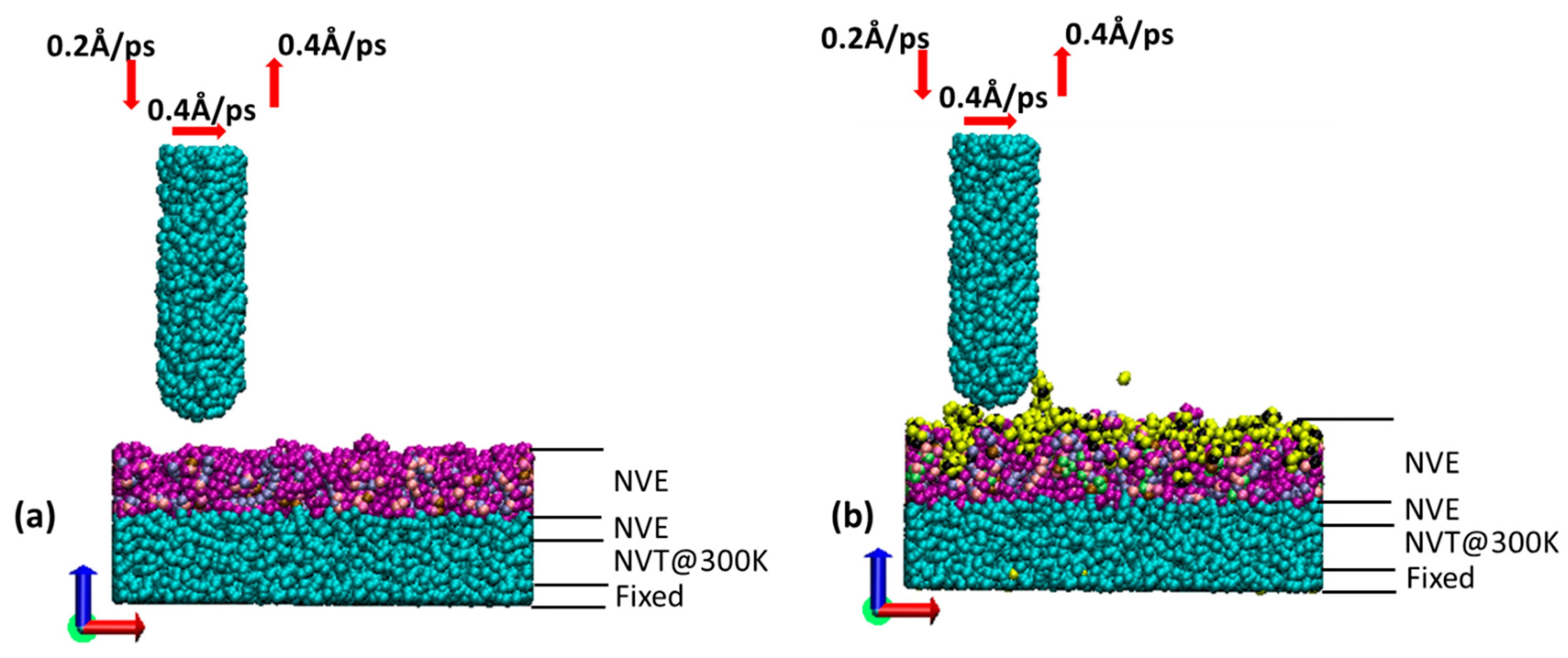
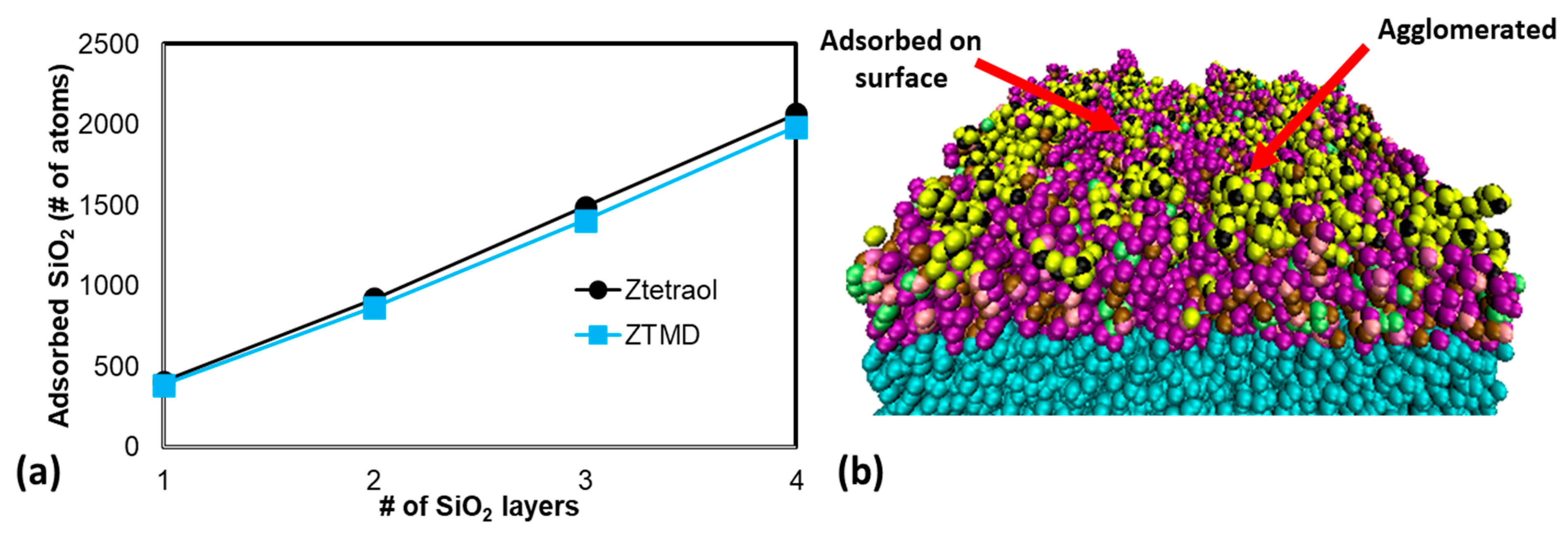
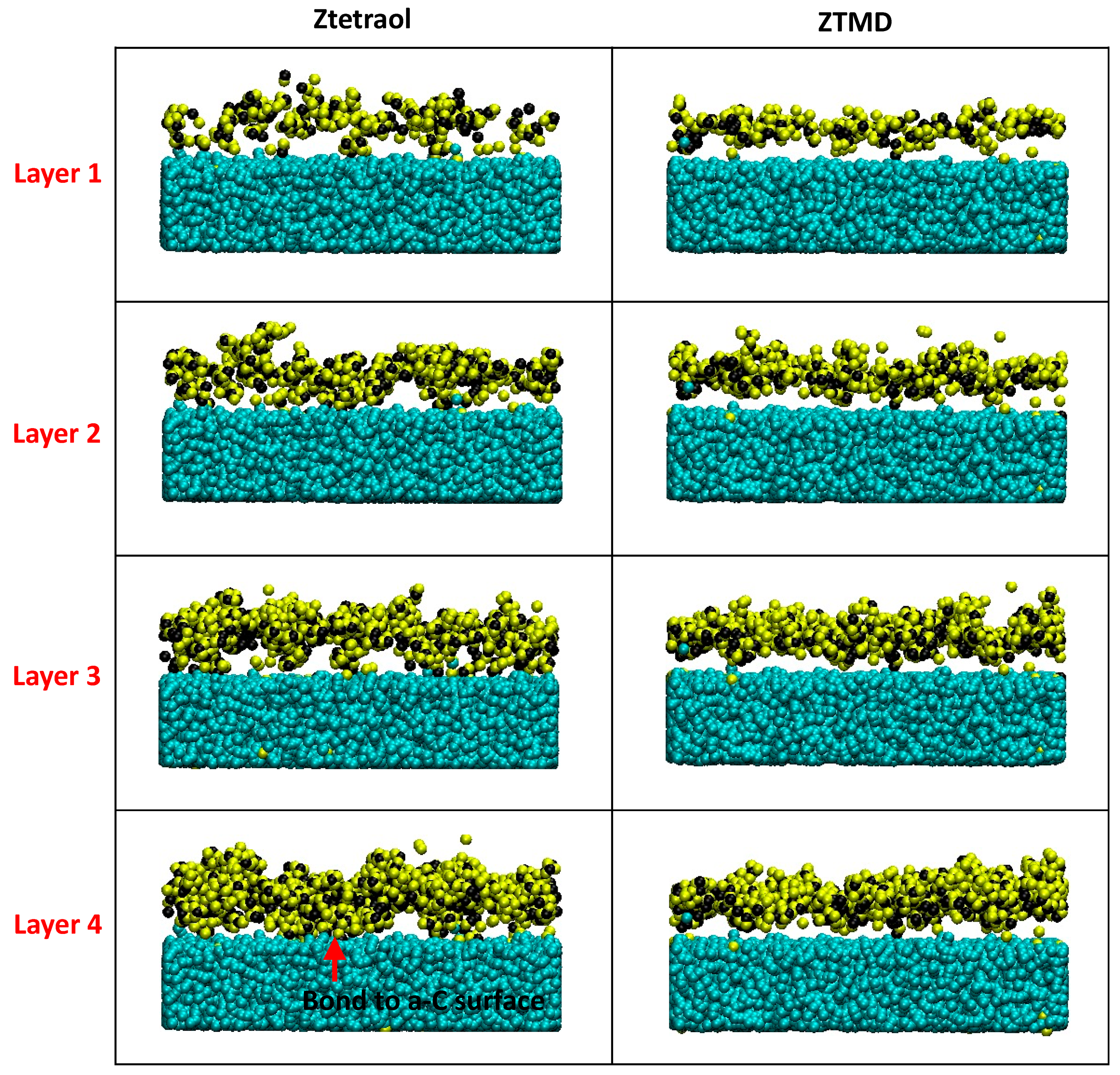
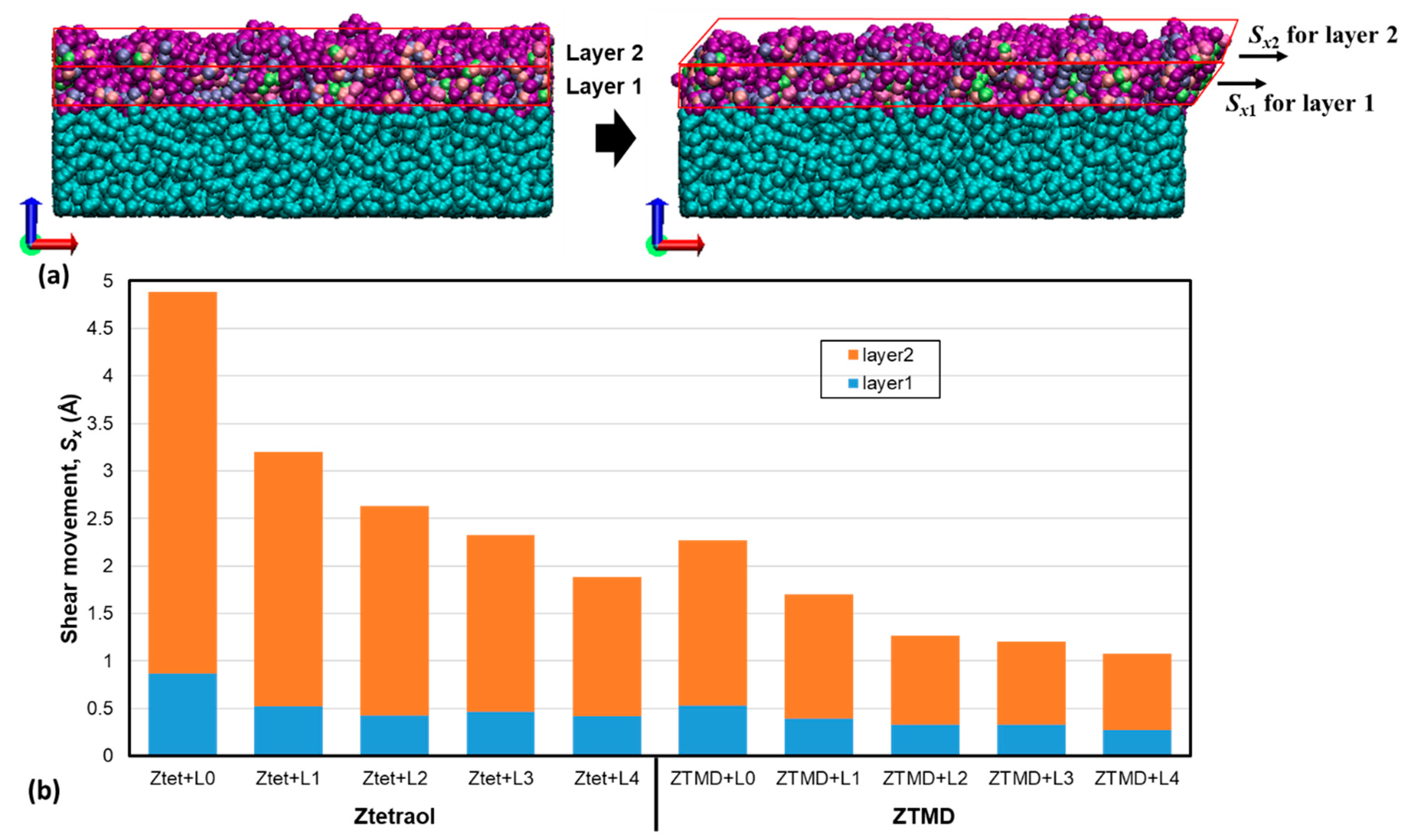
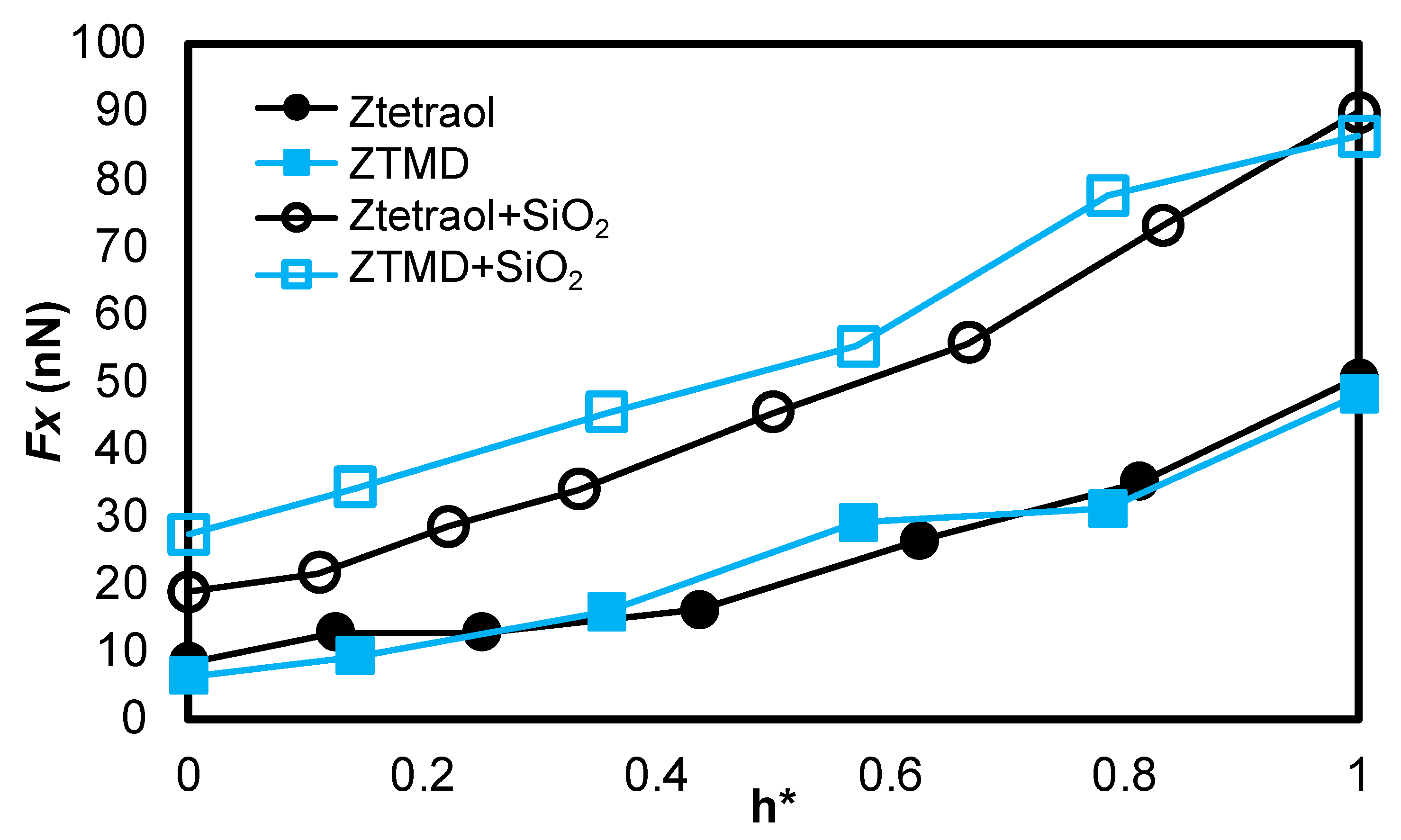
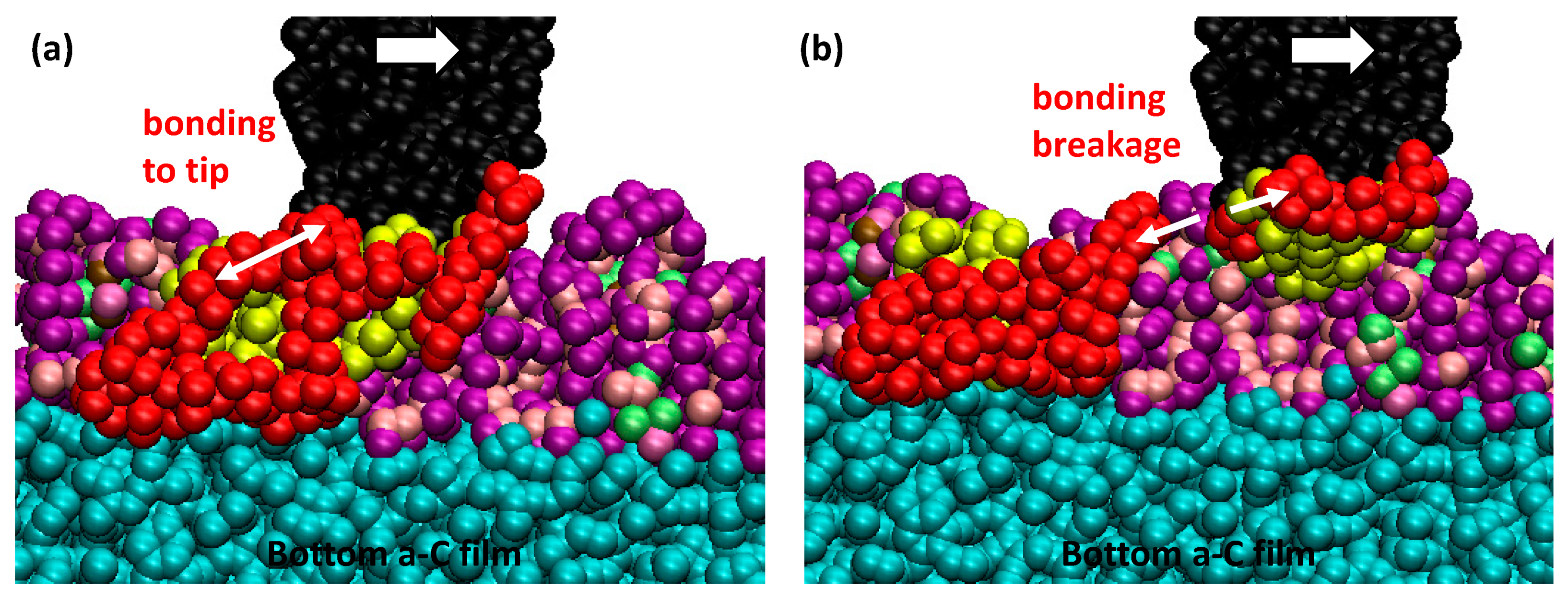
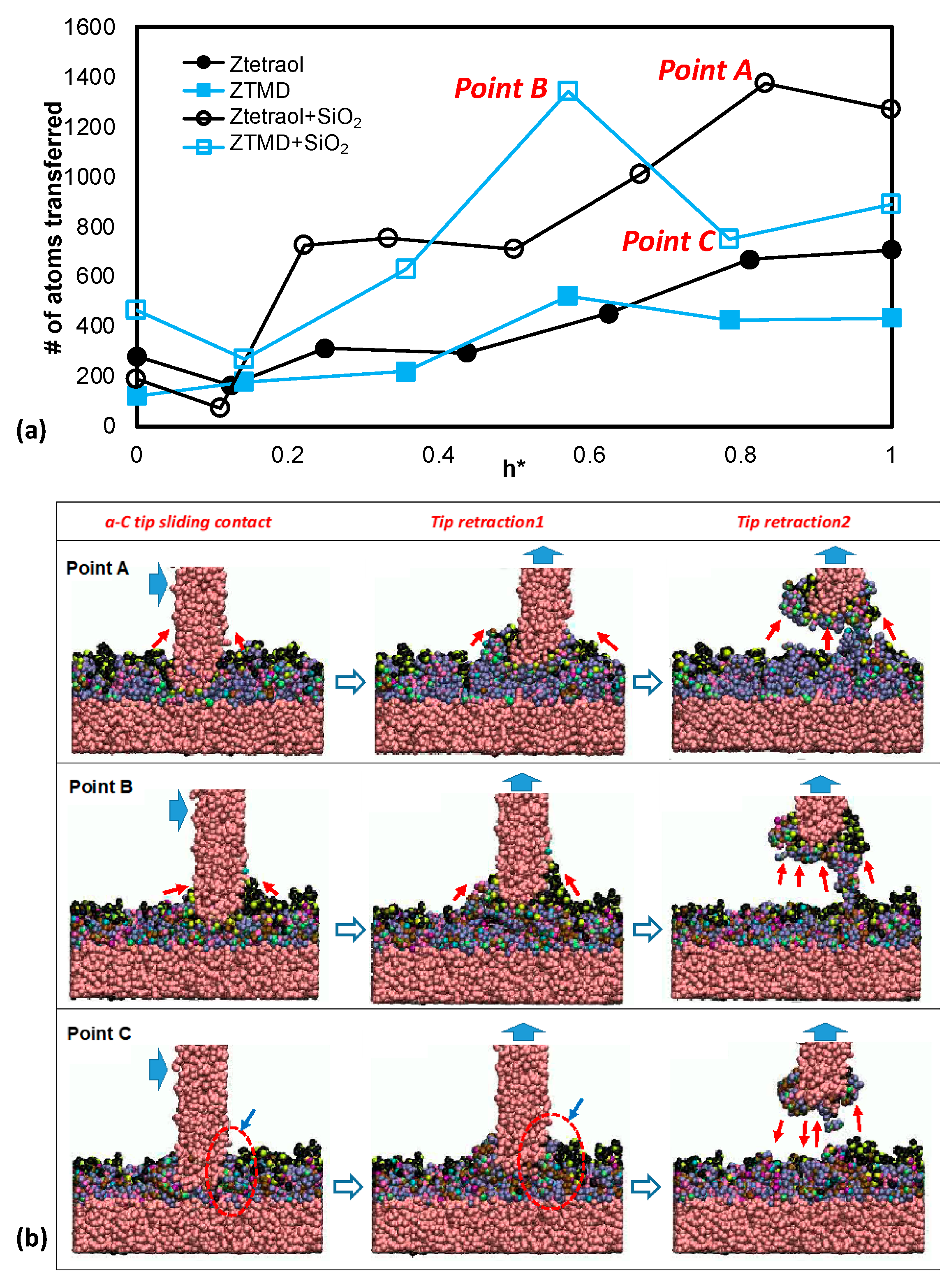
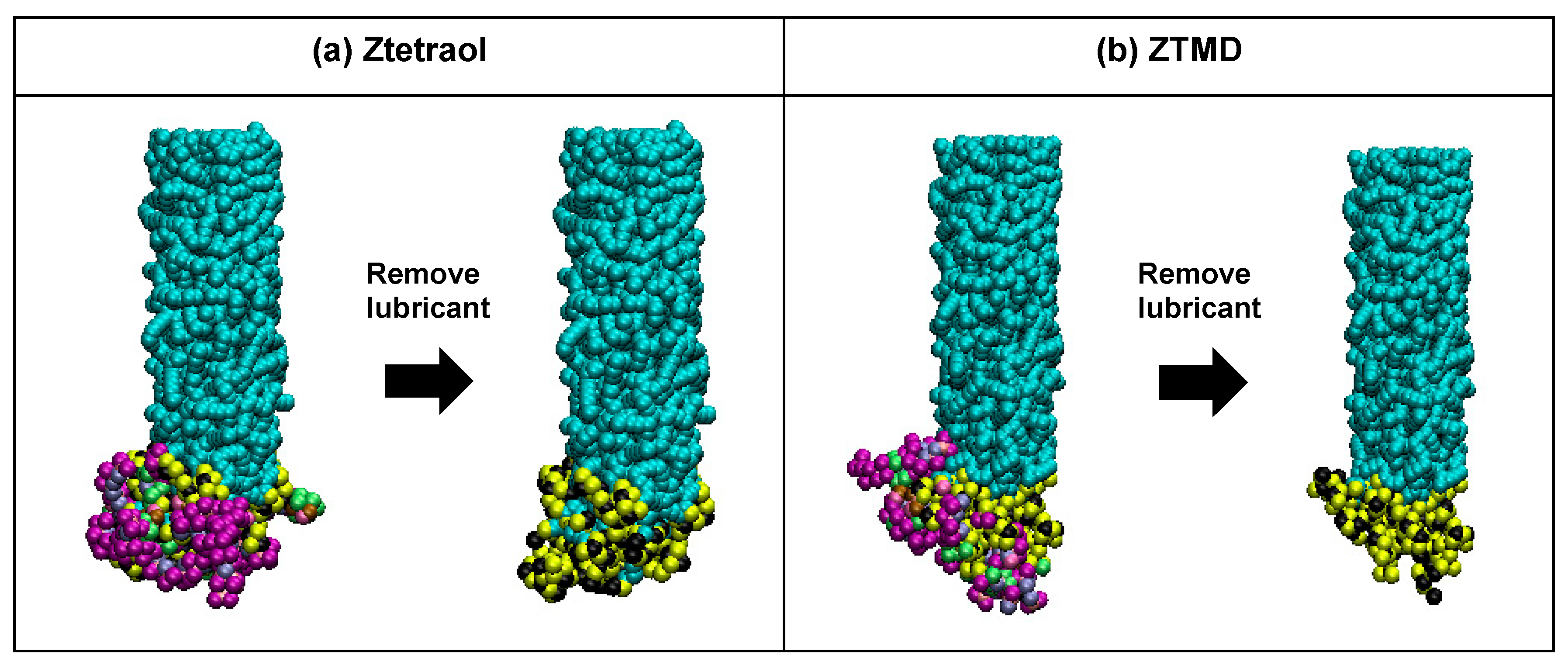
| Ztetraol | ZTMD | |
|---|---|---|
| # of atoms/chain | 169 | 203 |
| m/n value | 10/15 | 4/6 |
| MW (g/mol) | 2476 | 2608 |
Publisher’s Note: MDPI stays neutral with regard to jurisdictional claims in published maps and institutional affiliations. |
© 2021 by the authors. Licensee MDPI, Basel, Switzerland. This article is an open access article distributed under the terms and conditions of the Creative Commons Attribution (CC BY) license (https://creativecommons.org/licenses/by/4.0/).
Share and Cite
Rahman, S.; Purani, D.; Ali, S.; Yeo, C.-D. Effects of SiO2 Contaminant on Thermo-Mechanical/Chemical Properties and Lubricity of PFPE Lubricants. Lubricants 2021, 9, 90. https://doi.org/10.3390/lubricants9090090
Rahman S, Purani D, Ali S, Yeo C-D. Effects of SiO2 Contaminant on Thermo-Mechanical/Chemical Properties and Lubricity of PFPE Lubricants. Lubricants. 2021; 9(9):90. https://doi.org/10.3390/lubricants9090090
Chicago/Turabian StyleRahman, Shahriar, Dipesh Purani, Shaikh Ali, and Chang-Dong Yeo. 2021. "Effects of SiO2 Contaminant on Thermo-Mechanical/Chemical Properties and Lubricity of PFPE Lubricants" Lubricants 9, no. 9: 90. https://doi.org/10.3390/lubricants9090090
APA StyleRahman, S., Purani, D., Ali, S., & Yeo, C.-D. (2021). Effects of SiO2 Contaminant on Thermo-Mechanical/Chemical Properties and Lubricity of PFPE Lubricants. Lubricants, 9(9), 90. https://doi.org/10.3390/lubricants9090090





